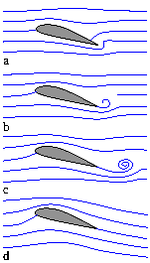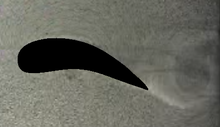Starting vortex

The starting vortex or free vortex is a vortex in aerodynamics that floats off the trailing edge of a wing when an aircraft takes off and is involved in the creation of lift.
At the beginning, the flow at the trailing edge of the profile generally has a higher velocity on the underside than on the upper side, and this difference fills the starting vortex. Because of the law of conservation of angular momentum , a counter-vortex arises, the bound vortex , which creates a circulation around the wing and with it dynamic lift . This is essential for a successful start , which shows the importance of the starting vortex.
The production of the start-up vortex ends when the speed difference at the trailing edge of the profile is balanced by a corresponding circulation, the flow is present and a fluid dynamic boundary layer has been built up. This process takes time. The starting eddy remains where it was created and dissipates over time.
theory
Wilhelm Kutta , and Nikolai Zhukovsky Jegorowitsch succeeded with flat circulation affected potential flow the buoyancy of a profile to be calculated. The wing and the circulation around it are extended infinitely perpendicular to the plane, because according to Helmholtz's third law of vortices , the vortex line of circulation in the fluid cannot end.
The idea of fulfilling this condition in a three-dimensional flow through a closed vortex ring as in Fig. 1 goes back to Ludwig Prandtl . This consists of the circulation-generating, bound vortex around the wing, the edge vortices and the starting vortex.
Emergence
Every flow of a homogeneous, frictionless liquid that arises out of rest is a potential flow. Such a circulation-free flow is shown in Fig. 2a, which during take-off runs into the circulation-affected flow in Fig. 2d. Between the blue streamlines, the volume flow is the same everywhere in the laminar area , see flow function . Where the streamlines are close together, the flow is accelerated, which, according to Bernoulli, lowers the pressure, and vice versa. At the trailing edge of the profile there is initially a singularity with infinite flow velocity. In the viscous air, the air flows around the trailing edge at a very high speed, with the flow coming off the top of the profile.
The jump in speed between the flow flowing off at the trailing edge below and above is compensated for in a finite length, unstable transition layer that rolls up into a vortex (Fig. 2b). In the borderline case of a viscosity-free flow, there is a discontinuity surface with rotation , i.e. a vortex surface . Off the surface, the rotation is zero.
The pressure is initially too high at the top and too low under the profile, which increases the flow velocity there and ignites the vortex. Fluid flows in from above between the wing accelerating to the left and the starting vortex that remains behind, which increases the speed on the upper side and reduces the pressure, so that the flow is increasingly applied (Fig. 2c).
The process ends when the speed difference at the trailing edge is equalized and the flow is present (Fig. 2d).
Since the buoyancy varies with every change in speed and inclination , and with it the circulation, a free vortex always swims away.
experiment
The approach vortex can be made visible in a bowl with water sprinkled with sawdust. For this purpose, the model of the profile of interest is drawn through the water, with a result comparable to Fig. 3.
Web links
- Ludwig Prandtl : Creation of eddies in water currents - 1. Creation of eddies and artificial influencing of eddy formation. Reich Institute for Film and Image in Science and Education (RWU) , 1936, accessed on May 8, 2020 (including the starting vortex of a wing with a moving and stationary camera).
Individual evidence
- ↑ Starting vortex . In: Lexicon of Physics . Spectrum Academic Publishing House, Heidelberg 1998 ( Spektrum.de ). , Oertel (2012), pp. 87, 209, Spurk (2010), pp. 126 f.
- ↑ after Peter Junglas: Fluid Mechanics 2. hydrofoil. Retrieved April 26, 2020 . Another presentation can be found in Spurk (2010), p. 126.
- ↑ Oertel (2012), p. 75.
- ↑ a b Spurk (2010), p. 125 f.
- ↑ Spurk (2010), p. 127.
- ↑ Fluid Dynamics. Kutta-Joukowski's Law. University of Würzburg, accessed on April 26, 2020 (post-processed still image from the embedded video 1).
- ↑ Wodzinski (1999), p. 20.
literature
- H. Oertel (ed.): Prandtl guide through fluid mechanics . Fundamentals and phenomena. 13th edition. Springer Vieweg, 2012, ISBN 978-3-8348-1918-5 , p. 86 ff .
- JH Spurk: Fluid Mechanics . Springer Verlag, Heidelberg, Dordrecht, London, New York 2010, ISBN 978-3-642-13142-4 , doi : 10.1007 / 978-3-642-13143-1 ( limited preview in the Google book search [accessed on 22. April 2020]).
- Rita Wodzinski: How do you explain flying in school? Attempt to analyze various explanatory models. (PDF; 288 kB) Plus Lucis Subject Didactics, 1999, accessed on April 20, 2020 .

